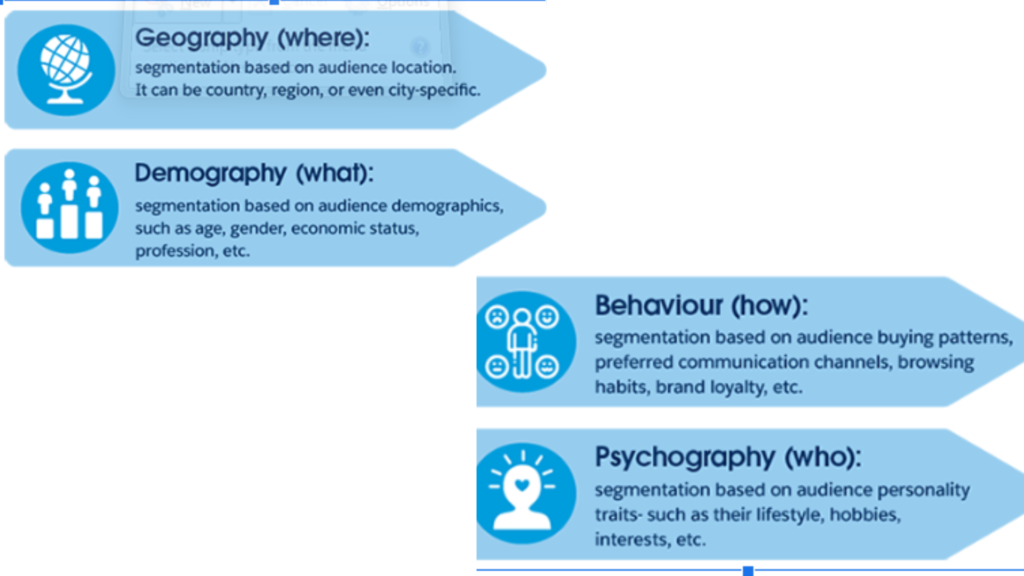Importance of Market Segmentation
If you’re a marketer, market segmentation helps you understand your target audience in a better way. You can use it and specify your strategies and determine a plan of action accordingly.
As someone dedicatedly building a marketing agency for 3 years now, I have very well understood that it is better to work on a well-segmented target audience than to haphazardly target everyone and wait for whoever comes back.
Lessons I learnt while hustling with MajesTEA
What is market segmentation?
The segmentation may assist marketers in defining and better understanding their target audiences and ideal consumers. It can also assist publishers in offering more precisely targeted marketing alternatives and customizing their content to suit various audience groups. It is significant for businesses since it decreases the money and effort marketing strategists invest into certain initiatives.
Market segmentation may be seen in everyday items, marketing, and advertising. Here are some marketing segmentation examples.
- Automakers thrive on their ability to accurately identify market groups and develop goods and advertising strategies that cater to those segments.
- Cereal manufacturers aggressively promote to three or four market segments at a time, promoting classic brands to existing customers and healthy products to health-conscious consumers.
- Elite athletes, frequent gym-goers, fashion-conscious ladies, and middle-aged men are among the target categories defined by sports-shoe producers.
This marketing intelligence allows them to design and advertise items with a heightened awareness more profitably than trying to market to the public at large.

Types of Segmentations
Market segmentation types are primarily divided into 4 categories. They are as follows:
- Demographic segmentation: One of the most prevalent ways of market segmentation is demographic segmentation. It separates consumers based on observable human distinctions and entails segmenting the market into consumer demographics based on criteria like age, gender, employment, level of income, marital status, country, and others. Companies use demographic surveys to collect statistical data on people. Some firms or goods target certain demographics based on at least one characteristic, whilst others are built with a specific population in mind.
- Geographic segmentation: It is a subtype of demographic segmentation in which clients are grouped based on their geographical location. It is beneficial for bigger corporations looking to grow into new branches, offices, or regions since it helps them to adjust their message to regional interests, languages, climate, or cultural norms. Geographic segmentation includes identifying users based on their nation, state, county, zip code, etc.
- Behavioural segmentation: It is a segmentation that allows firms to split audiences based on their actions and decisions. It is based on consumer behaviour, such as purchasing patterns, brand loyalty, use rate, advantages sought, conversion readiness, and conversion readiness. Variables are frequently gathered out of a person’s digital trail, such as their online behaviours and how they engage with the site and may be retrieved using various programs such as Google Analytics.
- Psychographic segmentation: A challenging market segmentation strategy that attempts to categorize customers based on their lifestyle, personality, attitudes, and interests. This segmentation gives deeper insights into a customer’s mind- by psychographic segmentation, it becomes easier for marketers to understand their audience deeply. Characteristics, interests, beliefs, values, attitudes, and lifestyles are all examples of psychographic features. Some effective ways to gain this kind of understanding: Focus groups, questionnaires, interviews, and testing.

Healthy Practices
There’s no greater way to boost your company’s profitability than to segment the broad market. These are some marketing segmentation best practices that have been created to assist you in executing this successfully.
- Main Objective: Businesses should prioritize website visitors and possibilities above the final goals of their company plan. They should also concentrate on the ROI they desire and attempt to increase their profitability. Every activity should serve to increase the number of visitors, conversion rates, and profitability.
- Practical Segmentation: Segments must be large enough to make targeting them valuable, and they must be completely exclusive, such that each individual may only sit in one. Too many divisions will make strategy management difficult, while too few will provide the precision you want. 5 to 8 parts are usually plenty.
- Avoid bias segmentation: Segmentation must include and be owned by everyone. The most crucial concept is to utilize extreme situations to determine where prospects fall. This will aid in identifying the many subgroups with which you will be interacting in the future.
- Judgment & Positioning: Product positioning is an important aspect of marketing to certain target groups. Important terminology and classifiers, in addition to human judgment, are essential. You can study the data, but exceptions will always exist. You may just use your judgment to integrate them into existing segments or build a new one for outliers. The first method is preferable to the second since there may be significant disparities in the targeted segment that make marketing to them unfeasible.
- Overall Goal: The overall goal of marketing segmentation is to discover distinctive and appealing values. Originality is vital, but it is also necessary to provide more than a basic survey of client segments. Segment evaluation assists in prioritizing and planning advancements depending on how effectively your segments are currently being met. It enables any organization to increase profitability by focusing on the marketing message.

Importance
Now, the question of the hour is, why is marketing segmentation important?
Market segmentation enables businesses to adjust their services, goods, or promotion to the unique demands of their target audience. Without this, businesses design a single plan for all target audiences, resulting in ineffective marketing efforts. Understanding the consumer guarantees that the firm continuously resonates with them, which leads to revenues, customer retention, and improved brand commitment.
We live in a dynamic environment, and businesses operate in the same. Given that everything is ever-changing, the tastes & preferences of the customers also evolve and vary from time to time. So, regularly practising market segmentation is also crucial for businesses to always understand their customers. And we could go on & on as to why this process is crucial, but we would want you to try & know yourself. So, if you are a business owner, let’s begin.
Gyaan zyada ho gaya? Koi nahi. Rest of our website is all fun and ready to entertain you. So, browse through Ye Bhi Theek Hai right away!









